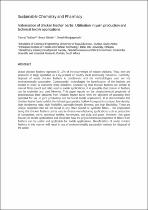 ResearchSpace
ResearchSpace
Valorisation of chicken feather barbs: Utilisation in yarn production and technical textile applications
JavaScript is disabled for your browser. Some features of this site may not work without it.
- ResearchSpace
- →
- Research Publications/Outputs
- →
- Journal Articles
- →
- View Item
| dc.contributor.author |
Tesfaye, T

|
|
| dc.contributor.author |
Sithole, Bishop B

|
|
| dc.contributor.author |
Ramjugernath, D

|
|
| dc.date.accessioned | 2019-04-10T11:00:09Z | |
| dc.date.available | 2019-04-10T11:00:09Z | |
| dc.date.issued | 2018-06 | |
| dc.identifier.citation | Tesfaye, T., Sithole, B.B. and Ramjugernath D. 2018. Valorisation of chicken feather barbs: Utilisation in yarn production and technical textile applications. Sustainable Chemistry and Pharmacy, vol 8, pp. 38-49 | en_US |
| dc.identifier.issn | 2352-5541 | |
| dc.identifier.uri | https://www.sciencedirect.com/science/article/pii/S2352554117300803 | |
| dc.identifier.uri | http://hdl.handle.net/10204/10945 | |
| dc.description | Copyright: 2018 Elsevier. Due to copyright restrictions, the attached PDF file only contains the abstract version of the full-text item. For access to the full-text item, please consult the publisher's website. The definitive version of the work is published in Sustainable Chemistry and Pharmacy, vol 8, pp. 38-49 | en_US |
| dc.description.abstract | Deep Learning has become a common applied technique to improve results in a variety of detection scenarios, including Synthetic Aperture Radar ship detection. One of the most common Deep Learning techniques, Convolutional Neural Networks, have provided excellent results but have a number of limitations such as pose/position invariance. If the position of an object relative to other objects is important these details may be lost by CNN. To combat this a new Deep Learning architecture known as Capsule Networks have been introduced. Capsule networks encode various object parameters in addition to feature values to attempt to improve upon convolutions. This paper introduces new ship detection technique based on Capsule Networks and was tested against two other machine learning techniques. The new architecture shows improved ship detection accuracy of 91.03% and false alarm rates of 9:5745 x 10(sup-9) and includes additional benefits such as requiring fewer samples/iterations to achieve improved performance. | en_US |
| dc.language.iso | en | en_US |
| dc.publisher | Elsevier | en_US |
| dc.relation.ispartofseries | Workflow;21848 | |
| dc.subject | Machine learning | en_US |
| dc.subject | Marine technology | en_US |
| dc.subject | Synthetic aperture radar | en_US |
| dc.title | Valorisation of chicken feather barbs: Utilisation in yarn production and technical textile applications | en_US |
| dc.type | Article | en_US |
| dc.identifier.apacitation | Tesfaye, T., Sithole, B. B., & Ramjugernath, D. (2018). Valorisation of chicken feather barbs: Utilisation in yarn production and technical textile applications. http://hdl.handle.net/10204/10945 | en_ZA |
| dc.identifier.chicagocitation | Tesfaye, T, Bishop B Sithole, and D Ramjugernath "Valorisation of chicken feather barbs: Utilisation in yarn production and technical textile applications." (2018) http://hdl.handle.net/10204/10945 | en_ZA |
| dc.identifier.vancouvercitation | Tesfaye T, Sithole BB, Ramjugernath D. Valorisation of chicken feather barbs: Utilisation in yarn production and technical textile applications. 2018; http://hdl.handle.net/10204/10945. | en_ZA |
| dc.identifier.ris | TY - Article AU - Tesfaye, T AU - Sithole, Bishop B AU - Ramjugernath, D AB - Deep Learning has become a common applied technique to improve results in a variety of detection scenarios, including Synthetic Aperture Radar ship detection. One of the most common Deep Learning techniques, Convolutional Neural Networks, have provided excellent results but have a number of limitations such as pose/position invariance. If the position of an object relative to other objects is important these details may be lost by CNN. To combat this a new Deep Learning architecture known as Capsule Networks have been introduced. Capsule networks encode various object parameters in addition to feature values to attempt to improve upon convolutions. This paper introduces new ship detection technique based on Capsule Networks and was tested against two other machine learning techniques. The new architecture shows improved ship detection accuracy of 91.03% and false alarm rates of 9:5745 x 10(sup-9) and includes additional benefits such as requiring fewer samples/iterations to achieve improved performance. DA - 2018-06 DB - ResearchSpace DP - CSIR KW - Machine learning KW - Marine technology KW - Synthetic aperture radar LK - https://researchspace.csir.co.za PY - 2018 SM - 2352-5541 T1 - Valorisation of chicken feather barbs: Utilisation in yarn production and technical textile applications TI - Valorisation of chicken feather barbs: Utilisation in yarn production and technical textile applications UR - http://hdl.handle.net/10204/10945 ER - | en_ZA |





